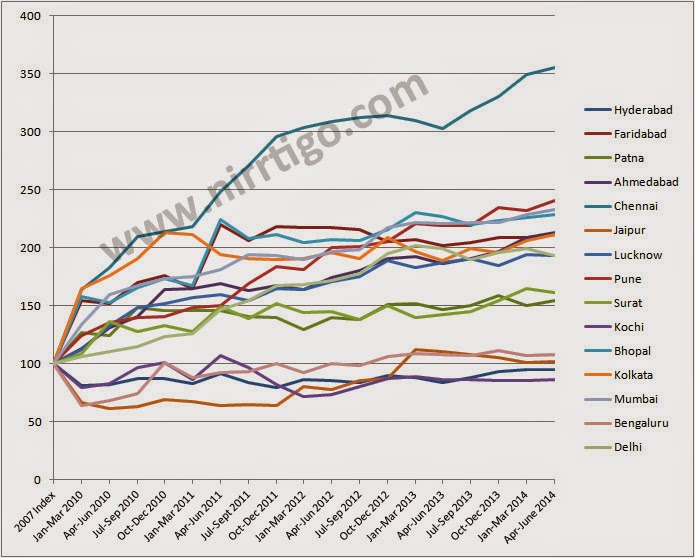Author: Sachin Gupta | Find me on Twitter Follow @sach_gupta
Have any Questions? Tweet to @sach_gupta
Ok, you have identified the residential property you wish to buy. Now comes the financing part of it. A residential property may cost you 50 Lacs or more. You may have arranged for the down payment cost of approximately 10 Lacs and are now looking to borrow the home loan for remainder of the property cost.
Borrowing home loan means you will be paying EMIs for several years. Therefore, one must be responsible and confident to service the debt over a period of time. Before sanctioning such a huge amount to an individual borrower, the banks carry out comprehensive due diligence that includes checking your credit history, bank statements, income statements, job or business continuity.
CIBIL score is one such parameter that banks and financial institutions look into before sanctioning loan. What is CIBIL score? Credit Information Bureau (India) Limited (CIBIL) is India’s first Credit Information Company (CIC) founded in August 2000. CIBIL collects and maintains records of an individual’s payments pertaining to loans and credit cards. These records are submitted to CIBIL by member banks and credit institutions, on a monthly basis. This information is then used to create Credit Information Reports (CIR) and credit scores which are provided to credit institutions in order to help evaluate and approve loan applications. (Definition Source: Wikipedia)
One can check the CIBIL score here
Follow @sach_gupta
Borrowing home loan means you will be paying EMIs for several years. Therefore, one must be responsible and confident to service the debt over a period of time. Before sanctioning such a huge amount to an individual borrower, the banks carry out comprehensive due diligence that includes checking your credit history, bank statements, income statements, job or business continuity.
CIBIL score is one such parameter that banks and financial institutions look into before sanctioning loan. What is CIBIL score? Credit Information Bureau (India) Limited (CIBIL) is India’s first Credit Information Company (CIC) founded in August 2000. CIBIL collects and maintains records of an individual’s payments pertaining to loans and credit cards. These records are submitted to CIBIL by member banks and credit institutions, on a monthly basis. This information is then used to create Credit Information Reports (CIR) and credit scores which are provided to credit institutions in order to help evaluate and approve loan applications. (Definition Source: Wikipedia)
One can check the CIBIL score here
How can you maintain good CIBIL score?
Well, in order to maintain good CIBIL score, you must pay attention to the following factors:
- Repayment:
First thing first, what is your repayment track record? In other words, are you paying your installments on previous loans or credit cards regularly within the stipulated timeline? If yes, then your CIBIL score is going to be good. Your ability to repay previous debt has 35% weight-age in calculation of the CIBIL Score. Therefore, make sure that you stick to due dates of servicing your EMIs.
- Credit Utilization:
Credit utilization is the ratio of the
Balance amount that you owe to your lenders / Total of your credit card limits
Therefore, if your balance amount that you owe to lenders is high then it signals riskiness. The increase in balance amount indicates increase in repayment burden and may negatively impact your CIBIL score. Credit utilization has 30% weight-age in calculation your CIBIL score. Therefore to score high CIBIL score, keep your outstanding balance to banks and financial institutions as low as possible.
- History of Debt servicing capacity:
Are you paying EMIs and credit installments successfully for several years? If yes, then this will have a positive impact on your CIBIL scores. Banks and financial institutions prefer applicants who have taken loans earlier and have serviced the debt regularly. It sends the signal that the individual has a long history of securing debt and has been responsible in his/her repayments. This has a weight-age of 15% in calculation of CIBIL score.
- New Credit
If you have applied for too many loans or credit cards in recent times, then it has a negative impact on your CIBIL score. Banks and financial institutions will see this increased activity of loan applications as risky because your debt burden has increased and it may affect your repayment capacity. Therefore, be prudent with your loan applications. Unless, your income has increased substantially, do not apply for too many loans or credit cards at the same time or within a short interval of time. In other words, space out your loan applications prudently. This has a weight-age of 10% in calculation of CIBIL score.
- Credit mix
Many a times, we have noticed that people have a great propensity to apply for unsecured loans. As the name suggests, unsecured loans are not secured by any mortgage or guarantee. If you have mostly availed unsecured loans (such as personal loans) or credit cards, then it will bring down your CIBIL score. Always have a mix of both secured loans and unsecured loans. Secured loans are car loan, home loan, etc. This has a weight-age of 10% in calculation of CIBIL score.
Now that, you have a thorough understanding of CIBIL scores and its impact on your loan availing ability, we hope that you will be disciplined in your finances.
Have any Questions? Tweet to @sach_gupta



